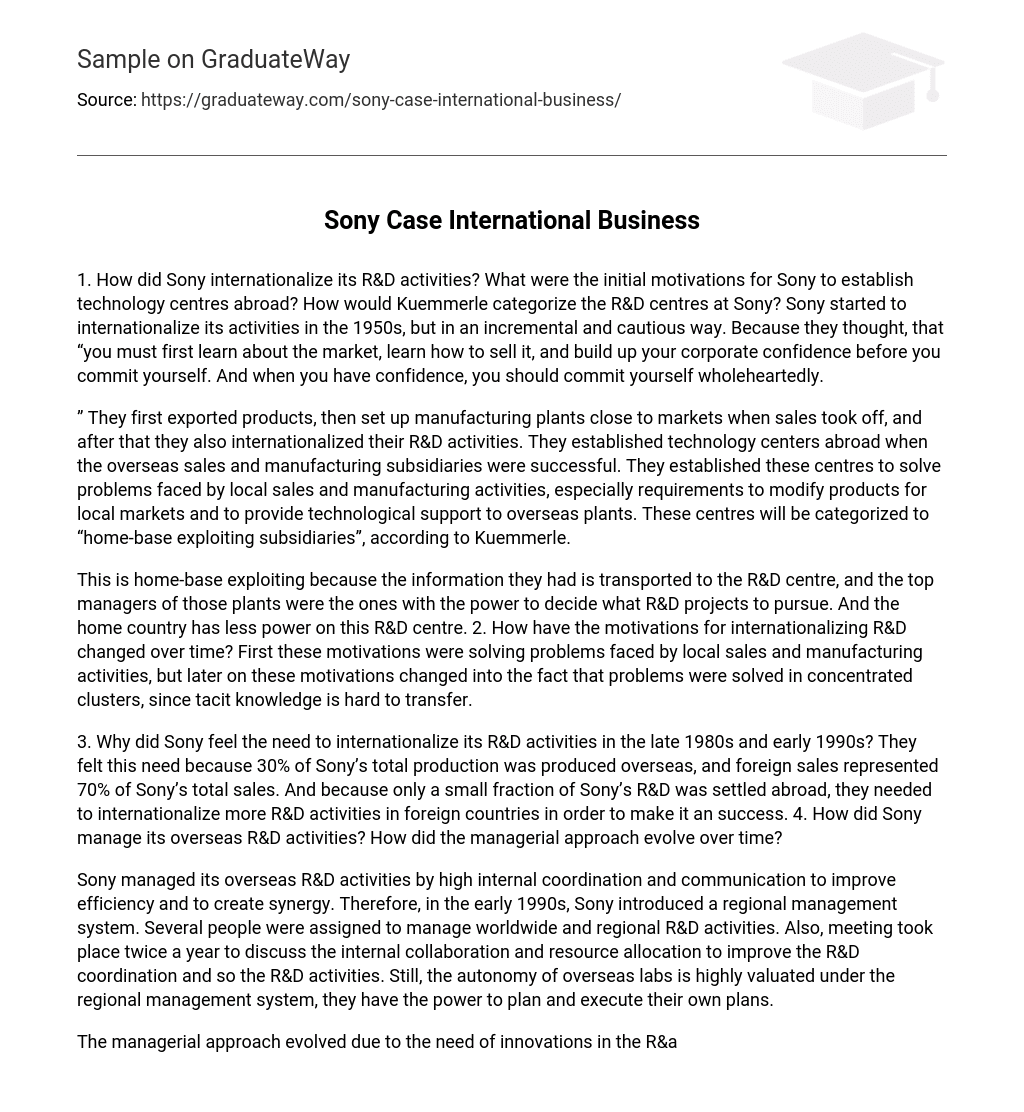1. How did Sony internationalize its R&D activities? What were the initial motivations for Sony to establish technology centres abroad? How would Kuemmerle categorize the R&D centres at Sony? Sony started to internationalize its activities in the 1950s, but in an incremental and cautious way. Because they thought, that “you must first learn about the market, learn how to sell it, and build up your corporate confidence before you commit yourself. And when you have confidence, you should commit yourself wholeheartedly.
” They first exported products, then set up manufacturing plants close to markets when sales took off, and after that they also internationalized their R&D activities. They established technology centers abroad when the overseas sales and manufacturing subsidiaries were successful. They established these centres to solve problems faced by local sales and manufacturing activities, especially requirements to modify products for local markets and to provide technological support to overseas plants. These centres will be categorized to “home-base exploiting subsidiaries”, according to Kuemmerle.
This is home-base exploiting because the information they had is transported to the R&D centre, and the top managers of those plants were the ones with the power to decide what R&D projects to pursue. And the home country has less power on this R&D centre. 2. How have the motivations for internationalizing R&D changed over time? First these motivations were solving problems faced by local sales and manufacturing activities, but later on these motivations changed into the fact that problems were solved in concentrated clusters, since tacit knowledge is hard to transfer.
3. Why did Sony feel the need to internationalize its R&D activities in the late 1980s and early 1990s? They felt this need because 30% of Sony’s total production was produced overseas, and foreign sales represented 70% of Sony’s total sales. And because only a small fraction of Sony’s R&D was settled abroad, they needed to internationalize more R&D activities in foreign countries in order to make it an success. 4. How did Sony manage its overseas R&D activities? How did the managerial approach evolve over time?
Sony managed its overseas R&D activities by high internal coordination and communication to improve efficiency and to create synergy. Therefore, in the early 1990s, Sony introduced a regional management system. Several people were assigned to manage worldwide and regional R&D activities. Also, meeting took place twice a year to discuss the internal collaboration and resource allocation to improve the R&D coordination and so the R&D activities. Still, the autonomy of overseas labs is highly valuated under the regional management system, they have the power to plan and execute their own plans.
The managerial approach evolved due to the need of innovations in the R&D activities. First, Sony has teamed up with other companies. Second, reducing management layers, improving coordination and refocussing on growth areas where main points of change. 5. What have been the problems with Sony’s way of managing R&D activities? Sony has been dominated by a silo structure, with little coordination among divisional managers. So, there has been insufficient coordination of resource allocation in R&D for improving existing products.
Under the decentralized structure, independent agendas which resulted in waste existed. Due to problems of duplication and insufficient coordination, Sony’s R&D efforts have been less effective than those of rivals. 6. Besides in-house restructuring to strengthen its technological capabilities, what did Sony do to rejuvenate its businesses? Sony has started to form strategic alliances to compete in the competitive environment. Sony also has invested in R&D resources to improve environmental performance. In addition, they expended to different sectors, for example the health sector.
Furthermore, Sony has begun to outsource certain parts of the value chain to decrease costs. Extremely important for Sony will be to improving operational efficiency. 7. Can you provide an update on the internationalization of Sony’s R&D activities, using materials available on the Web? January 08, 2013 Sony develops the World’s First and Largest “56-inch 4K OLED TV”- Prototype to be exhibited at 2013 International CES – In this article 1, you can read that Sony developed this TV with a joint venture. Thus they are presuming their restructuring.





